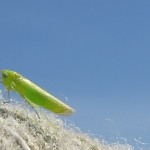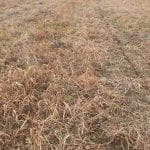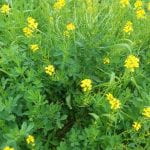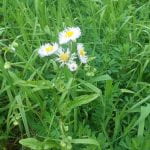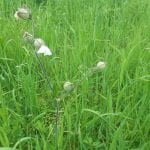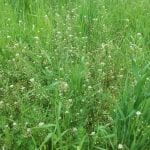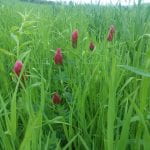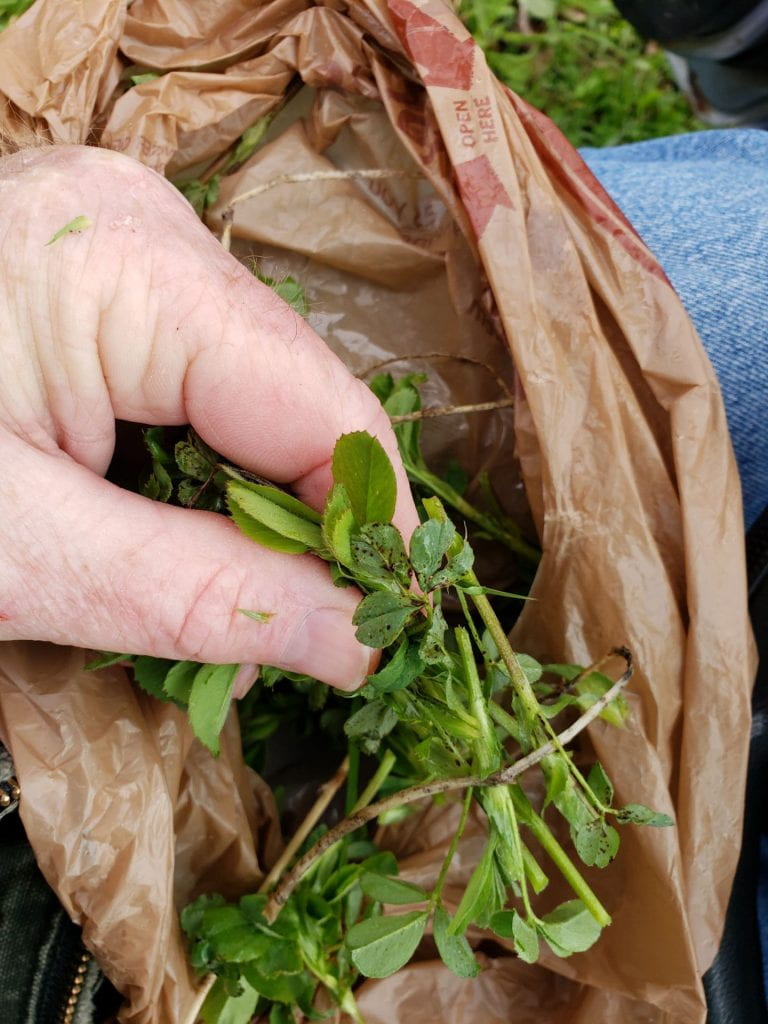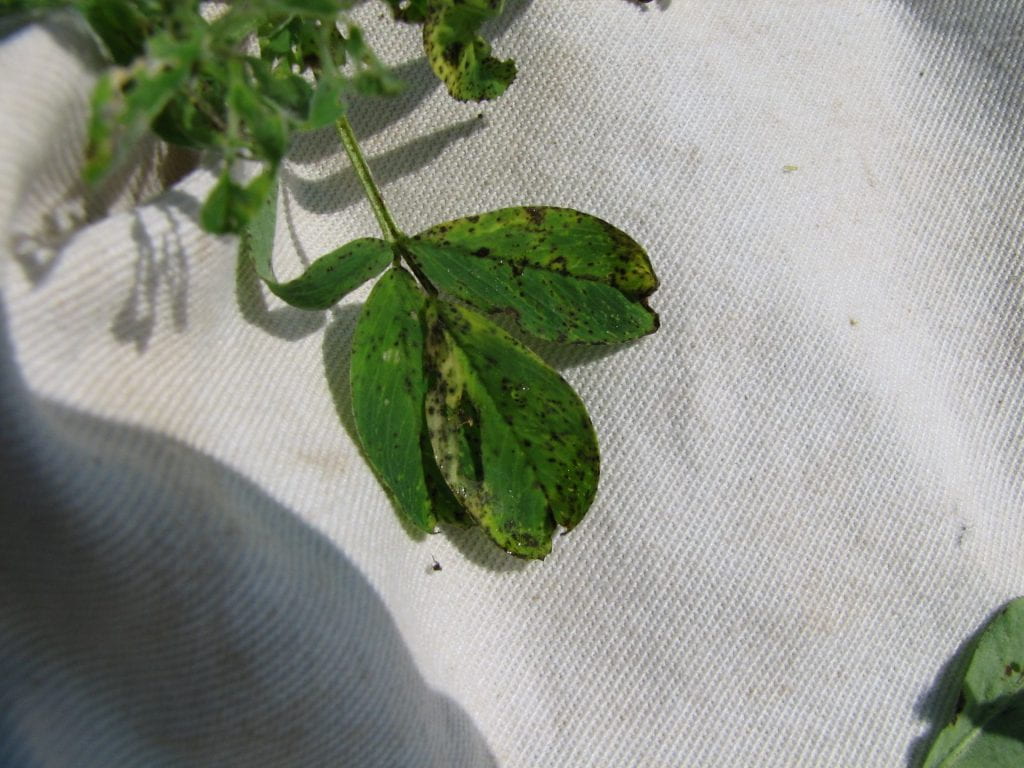Volume 18-Number 5
Contents
View from the Field
Numerous potato leafhopper adults were found in alfalfa near Amenia, NY this week. As the weather, starts to warm potato leafhopper populations can increase in alfalfa. The best thing to do is get out and look for the pest in your alfalfa.
How to Scout for Potato Leafhopper video
I was scouting some emerging corn this week in a no-tilled field. Before the herbicide burn-down, there were many weedy grasses in the field. Black cutworm moths can lay eggs on these grasses. After the eggs hatch the grasses are gone and they will feed on the corn. I did not find any black cutworms but it is too early for them to hatch. I would keep an eye out for cutworm damage in this situation.
Alfalfa weevil larvae are starting to appear in alfalfa. Once it is dry enough to cut alfalfa, watch the regrowth for possible damage. This year since it was so cool weevils are most likely behind alfalfa development. In years like this weevil can hold over and feed on the regrowth.
Early season flowering plants provide pollen to many bees and other pollinators in the spring. Most alfalfa in the NE has many other plants in the field other than alfalfa. Most call them weeds but to pollinators, they are a source of pollen. Plants found this week with early season pollen sources were:
Weather Outlook – May 30, 2019
Jessica Spaccio
NOAA Northeast Regional Climate Center
Cornell University
Last week temperatures ranged from 4 degrees below-normal to 6 degrees above-normal. Precipitation has ranged from a tenth to over 1.5”. Base 50 growing degree-days ranged from 20 to 100.
Most of the forecast period with be unsettled with scattered showers. Friday will be sunny & dry.
Today temperatures will be in the mid 60s to mid 70s with showers and some thunderstorms. Overnight lows will be in the 40s and 50s.
Friday will become sunny and dry with temperatures in 60s to mid 70s. Overnight temperatures will be in the 40s and low 50s
Saturday temperatures will be in the mid 60s to mid 70s; a cold front will bring showers and thunderstorms across the state. Overnight temperatures will be in the upper 40s to 50s.
Sunday highs will be in the mid 60s to mid 70s with showers and thunderstorms possible. Overnight temperatures will be in the mid 40s to mid 50s.
Monday temperatures will be in the 60s and low 70s with scattered showers. Overnight temperatures will be in the mid 40s to mid 50s.
Tuesday highs will be slightly cooler in the 60s, with scattered showers possible. Overnight temperatures will be in the mid 40s to mid 50s.
Wednesday highs will be in the 60s. Overnight temperatures will be in the mid 40s to mid 50s.
The seven-day precipitation amounts will range from ½” to 1 ½” .
The 8-14 day outlook (June 6-12) favors above-normal temperatures for western to central to southeast NY. Below-normal precipitation is slightly favored for the state.
Maps of 8-14 day outlooks:
http://www.cpc.ncep.noaa.gov/products/predictions/814day/index.php
National Weather Service watch/warnings map:
US Drought Monitor
http://droughtmonitor.unl.edu/Home.aspx
Drought Impact Reporter:
https://droughtreporter.unl.edu/map/
CLIMOD2 (NRCC data interface):
http://climodtest.nrcc.cornell.edu
Spring Black Stem and Leaf Spot is Prevalent in Many Alfalfa Fields
By Jaime Cummings, NYS Integrated Pest Management Program, and Jeff Miller, CCE Oneida County
Healthy alfalfa field near Aurora, NY, May 2019. (Photo by J. Cummings, NYS IPM)
Reports have been coming in regarding foliar diseases in alfalfa over the last couple weeks. One in particular, Spring Black Stem and Leaf Spot (caused by Phoma medicaginis), seems to be quite prevalent in many fields this spring. It’s no surprise, given this wet weather that this fungal disease is thriving in our lush alfalfa fields. It is considered to be one of the most common and problematic foliar diseases in NY, and may result in significant yield losses under severe disease pressure. Not only does it reduce the photosynthetic potential of the leaves that are covered in spots, but it can also weaken plants overall, resulting in diminished crowns and roots. This also translates to a potential reduction in quality as it can decrease crude protein levels of the forage or hay.
Figure 1. Early season symptoms of spring black stem and leaf spot on alfalfa. (Photo by Jeff Miller, CCE Oneida County)
The pathogen overwinters on alfalfa residues and crown lesions. During a cool, wet spring, it produces abundant spores which are spread through the canopy by splashing rain and dew, but they can also be wind-disseminated. The spores germinate on the alfalfa foliage and the fungus penetrates the plant via stomata or wounds and can move systemically through the plant down into the crown and tap root. This disease can have multiple cycles in a given year, if the weather is conducive.
Contrary to its name, the symptoms of this disease are usually most obvious first on the leaves, though it’s not uncommon to find lesions on the stems and the disease progresses (Fig. 1). As its name suggests, you’ll see small distinct black spots on the leaves, which may enlarge and merge, covering large portions of leaflets. Similar lesions may appear on petioles and stems, and in severe cases, entire stems may turn black. Severe infection may result in defoliation starting in the lower canopy, and stems may be killed.
Typically, this disease is most problematic in first cutting, and can often be managed with an early harvest. However, given the wet conditions we are currently experiencing, and may continue to see, this disease may linger and progress through the canopy into second cutting. Keep an eye on your fields after first cutting to determine if it continues to be problematic.
Figure 2. Comparison of alfalfa treated with a fungicide vs. the non-treated control for managing spring black stem and leaf spot. (Image courtesy of D. Samac, USDA, St. Paul, MN) https://alfalfa.ucdavis.edu/+symposium/2015/powerpoints/14_SamacAlfalfaDiseases.pdf
The best control options for this disease involve an integrated management approach. Since it can be introduced to a field on seed, be sure to plant clean, certified seed and utilize cultural methods like crop rotation to minimize inoculum within a field. Unfortunately, no highly resistant cultivars are currently available against this disease. As mentioned previously, it is often best managed in first cutting with an early harvest. However, if the epidemic continues severely into second cutting, you may consider a fungicide application (Fig. 2). A few fungicides are labeled for use on alfalfa against spring black stem and leaf spot in NY, including Endura, Headline and Quadris, though trial results from Wisconsin have not shown applications to be consistently cost-effective (Fig. 3). Always follow all labels and restrictions when applying pesticides, and pay particular restrictions for applications on mixed stands and post-harvest intervals.
Figure 3. Estimation of the probability of return on investment of fungicide applications in alfalfa. (Image courtesy of D. Smith, S. Chapman, B. Jensen, G. Blonde, B. Halfman and D. Undersander, University of Wisconsin Extension)
Spring Foliar Alfalfa Diseases Affecting Fields in New York State
Ken Wise, NYS IPM
We have observed several alfalfa disease issues (mostly spring black stem) this spring because of the cool wet weather. Many of these foliar diseases can cause the leaflets to fall off early. If you are able to harvest early, this will generally stop the progress of the disease because the weather conditions in early to mid-summer change.
Spring Black Stem (SBS): SBS overwinters on stems and leaves on the surface of the soil from the previous year. This SBS likes cool and moist weather in early spring. In springs when there is excess rain it will move the fungus on to the plants at high rates and increase infections. Symptoms appear as irregularly shaped brown to black spots that can merge to form a larger blotch. This disease can infect the leaflet and form elongated blackened areas on the stems. When this disease are at epidemic levels can cause stem and crown or root rots.
Common Leaf Spot (CLS): CLS occurs with cool and wet conditions. CLS appears on the lower leaflets and then moves into the upper canopy. The lesions are small and circular. They are brown to black and with the spot being 1/16 inch in diameter. Use a hand lens and you will see tiny raised, fruiting bodies that are brown in the center of the lesions. This is where fungal spores are released to infect more of the plant. Many times this disease occurs in poorly managed fertility in fields. CLS seems to appear in soils are acidic. See photo at: Common Leaf Spot
Leptosphaerulina Leaf Spot (LLS): LLS occurs with cool and moist weather in early spring. The lesions are tiny black spots. They will increase in size (1/16 to 1/8 inch) and become oval or round. In time, they turn brown to tan with a dark border. LLS infects young leaflets and possibly parts of the plant. See photo at: Leptosphaerulina Leaf Spot
Downy Mildew (DW): DW causes the leaflets to become light green or yellow and blotched. A purple to gray mold coats the underside of the leaves. This disease is common early in the spring. See photo: Downy Mildew
Management
- There are no fungicide rescue treatments to manage these diseases.
- Use cultural practices and resistant varieties to minimize disease problems.
- Good crop management helps reduce disease infections in the spring. Reduced stress on the plant will help it resist disease
- Avoid planting alfalfa in fields that had legumes the previous year.
- Good seedbed preparation
- Control weeds at planting
- Maintain the pH to 6.5 or above, and balanced fertilization
Understanding Alfalfa Weevil Degree Days
I found several 1st instar alfalfa weevil larvae this week. In many areas, you may have not reached the 280-alfalfa weevil degree days for eggs to hatch but still are finding small larvae. Note that each field has its own microclimate. One field may be warmer than others. For example, a south facing slope will accumulate growing degree-days more quickly than other fields. The second thing is that the model below is based on when 50% of alfalfa weevil is in a specific stage of development. This means there will be some larvae before and after the peak at specific stages of growth.
Growing degree Days for peak (50%) Occurrence of Alfalfa Weevil growth stage:
Stage or Event Accumulated growing degree days*
Eggs hatch 280
Instar 1 315
Instar 2 395
Instar 3 470
Instar 4 550
Cocconing 600
Pupa 725
Adult Emergence 815
* 48F base temperature
Black Cutworm Moth Weekly Pheromone Captures
True Armyworm Moth Weekly Pheromone Captures
New York Field Crop Pest Degree Day Accumulations for selected locations
(May 31, 2019)
Clipboard Checklist
Keith Waldron, NYS IPM
General
*Pre- and post-plant weed evaluation, timing cultivation and/or post-emergent weed management
*Watch for early season weeds: winter annuals, chickweed, henbit, field penny cress, shepherd’s purse, giant and common ragweed, purple deadnettle, lambsquarters, redroot pigweed, velvet leaf, Pennsylvania smartweed, common sunflower, quackgrass, foxtail
Alfalfa:
*Evaluate established legume stands for harvest.
*Monitor for alfalfa weevil, crown or foliar diseases
*Monitor new seedings for Pythium blight and Phytopthora Root Rot.
*Monitor for Alfalfa Snout Beetle (In Oswego, Jefferson, Cayuga, Wayne, Lewis, St. Lawrence, Clinton, Essex, and Franklin counties)
Small Grains:
*Monitor winter grain fields for growth stage, disease presence or risk, weed issues (such as winter annuals, corn chamomile and chickweed), growth stage, number of tillers
* Evaluate stands for risk of fungal diseases (See above Dr. Bergstrom’s article above)
*Check stands for soilborne virus diseases, Wheat spindle streak mosaic and Soilborne wheat mosaic, check for signs of powdery mildew or other maladies, cereal leaf beetle, weed escapes, goose damage
Corn:
*Plant corn as conditions allow
*Pre- and post-plant weed evaluation, timing cultivation and/or pre- and post-plant weed management
*Emergence: assess stand, population count, bird and early season insect issues e.g. black cutworm, wireworm, white grubs.
Soybeans:
*Plant soybeans as conditions allow
*Pre- and post-plant weed evaluation, timing cultivation and/or post emergence weed management
*Emergence: assess stand, population count
Pastures:
*Check and mend fences as needed.
*Check crop growth
*Monitor fields for invasive species, plants harmful to livestock
*Review/Plan rotation system
Equipment:
*Remove / clean soil and crop debris from equipment
*Arrange for custom weed control or check your own application or cultivator equipment for repairs.
*Carry appropriate / necessary NYS DEC and EPA required documents: (pesticide applicators license, pesticide labels, MSDS sheets, etc.) with application equipment
*Calibrate:
-planting equipment – maintain records on planting rate per field
-manure spreaders – maintain records on amount spread per field
-pesticide application equipment – Check nozzles, pumps, etc., recalibrate pesticide application equipment before use.
Storage:
* Check stored grain bins for temperature, moisture and signs of mold and insects. Aerate, core, transfer grain or treat as necessary
*Check forage allocation and anticipate feed program adjustments as forages from previous year are used up
*Plan where forages should be stored for optimum allocation next feeding season


